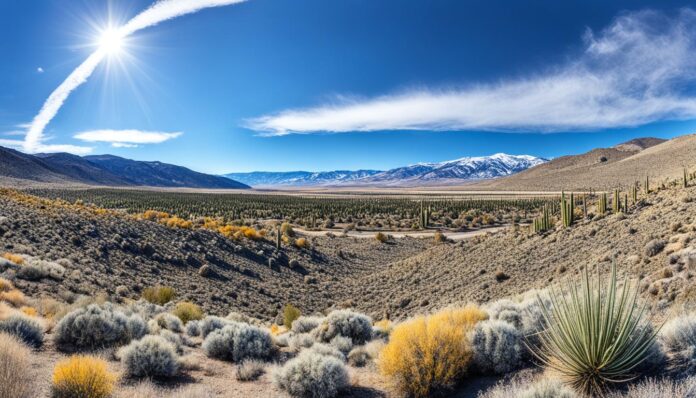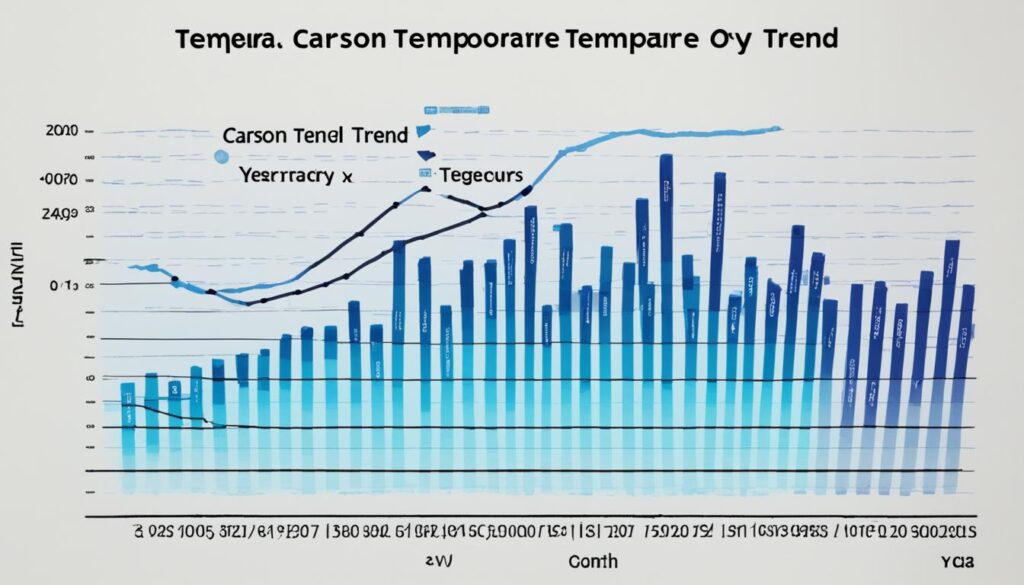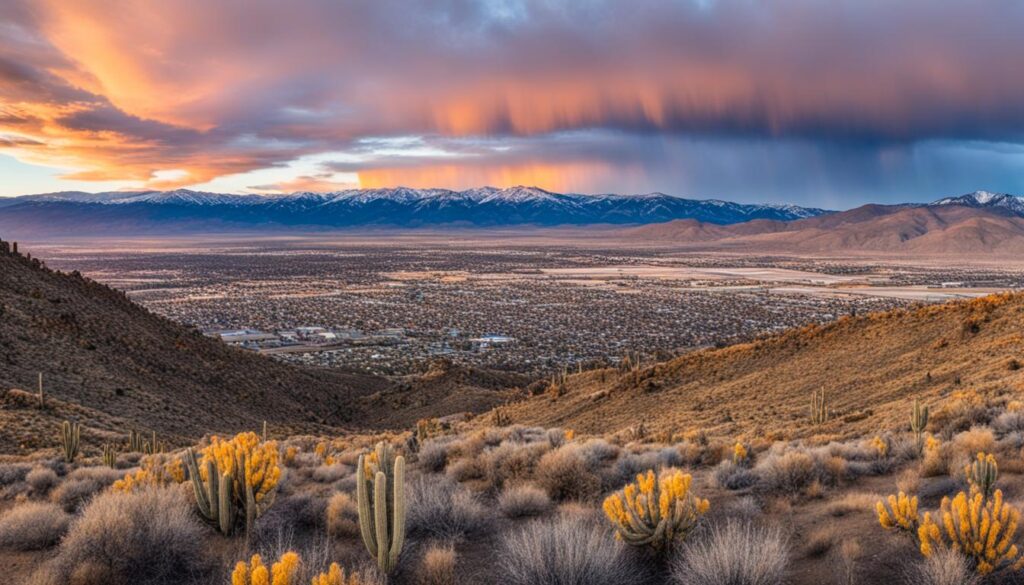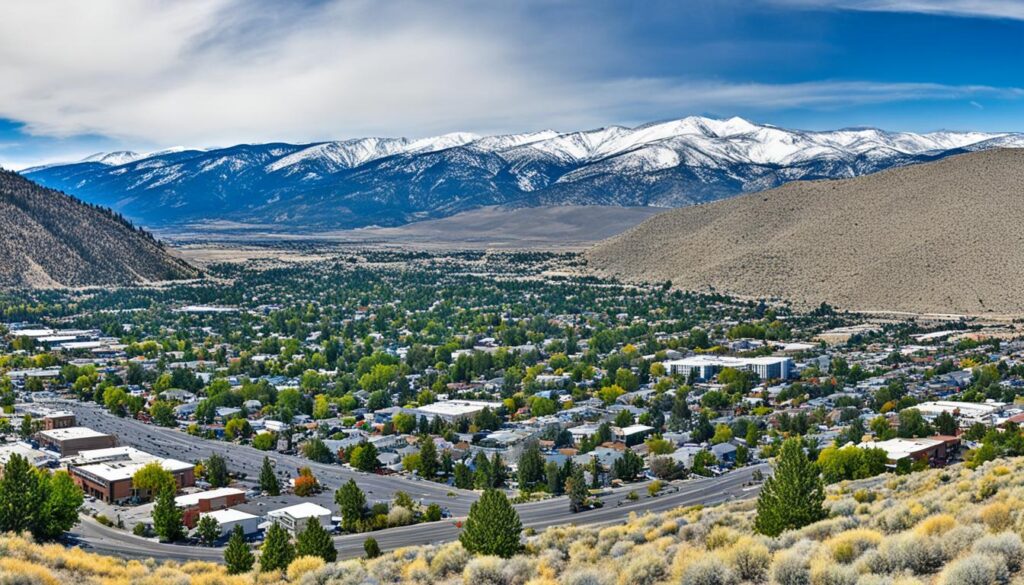Are you planning a trip to Carson City and wondering what the weather will be like? How hot does it get in the summer? How much rain or snow can you expect during your visit? Understanding the climate of Carson City is essential for a smooth and enjoyable trip. With our comprehensive climate overview, you’ll have all the information you need to prepare for any type of weather that comes your way.
Introduction to Carson City’s Climate
When planning a trip to Carson City, it’s essential to familiarize yourself with the city’s unique climate. Understanding the weather patterns can help you pack appropriately, plan outdoor activities accordingly, and ensure a more enjoyable visit. Whether you’re an adventure seeker, a nature lover, or a history enthusiast, knowing what to expect from Carson City’s climate is key to making the most of your trip.
Carson City experiences a semi-arid climate, characterized by hot summers and cold winters. The city’s location in the western United States and its elevation of 4,802 feet (1,464 meters) contribute to its distinctive weather patterns. The nearby Sierra Nevada mountain range has a significant impact on the climate, influencing temperature fluctuations and precipitation levels throughout the year.
Throughout this section, we will explore the climate overview of Carson City, delve into year-round weather patterns, examine temperature ranges, discuss precipitation levels, analyze climate data and trends, highlight important climate facts, and provide guidance on dressing appropriately for the Carson City climate. Let’s get started!
Buckle up and get ready to discover the fascinating climate of Carson City. From warm summer days that beckon outdoor adventures to snowy winter landscapes perfect for skiing, this article will equip you with valuable insights to enhance your visit. So, grab your sunscreen and your winter coat and let’s explore Carson City’s weather together.
Yearly Weather Patterns in Carson City
When planning a visit to Carson City, it’s crucial to understand the yearly weather patterns that shape the climate. With distinct seasons and varying temperatures, being prepared will ensure a comfortable and enjoyable experience throughout the year.
Spring (March-May)
Spring in Carson City brings mild temperatures, making it an ideal time to explore the outdoors. Average highs range from 59°F (15°C) in March to 71°F (22°C) in May, while lows range from 32°F (0°C) in March to 42°F (6°C) in May. Keep in mind that spring can be unpredictable, with occasional rain showers.
Summer (June-August)
The summer months in Carson City are characterized by warm temperatures and long sunny days. Average highs range from 83°F (28°C) in June to 91°F (33°C) in August, with lows ranging from 49°F (9°C) in June to 53°F (12°C) in August. Be prepared for occasional thunderstorms in the afternoon.
Fall (September-November)
Fall in Carson City is known for its pleasant weather and vibrant foliage. Average highs range from 76°F (24°C) in September to 63°F (17°C) in November, while lows range from 43°F (6°C) in September to 31°F (-1°C) in November. The crisp air and cooler temperatures create a picturesque setting for outdoor activities.
Winter (December-February)
Winter in Carson City brings chilly temperatures and occasional snowfall. Average highs range from 47°F (8°C) in December to 51°F (11°C) in February, while lows range from 20°F (-7°C) in December to 23°F (-5°C) in February. It’s important to bundle up and be prepared for winter driving conditions.
Take a look at the table below for a summary of the average temperature ranges in Carson City throughout the year:
| Season | Average High | Average Low |
|---|---|---|
| Spring | 59°F (15°C) – 71°F (22°C) | 32°F (0°C) – 42°F (6°C) |
| Summer | 83°F (28°C) – 91°F (33°C) | 49°F (9°C) – 53°F (12°C) |
| Fall | 76°F (24°C) – 63°F (17°C) | 43°F (6°C) – 31°F (-1°C) |
| Winter | 47°F (8°C) – 51°F (11°C) | 20°F (-7°C) – 23°F (-5°C) |
The seasons in Carson City offer a diverse range of weather conditions, allowing visitors to experience the city’s natural beauty throughout the year. Whether you’re planning a hike in the spring, a summer getaway, an autumn road trip, or a winter adventure, understanding the yearly weather patterns will help you make the most of your visit.
Temperature Ranges in Carson City
When planning your visit to Carson City, it’s essential to have a good understanding of the temperature ranges throughout the year. The city experiences distinct seasons, each with its own average highs and lows that can greatly impact your experience.
Seasonal Temperature Averages
Here’s a breakdown of the average temperatures you can expect in Carson City:
| Season | Average High | Average Low |
|---|---|---|
| Spring | 58°F (14°C) | 34°F (1°C) |
| Summer | 85°F (29°C) | 51°F (11°C) |
| Fall | 68°F (20°C) | 37°F (3°C) |
| Winter | 46°F (8°C) | 21°F (-6°C) |
As you can see, temperatures in Carson City can vary significantly depending on the season. Summers are warm with average highs around 85°F (29°C), while winters can be chilly with temperatures dropping to an average low of 21°F (-6°C).
It’s important to note that these are average temperatures, and actual conditions can vary. It’s always a good idea to check the forecast closer to your visit for the most accurate information.
Keep in mind that temperature fluctuations can impact your outdoor activities. Whether you’re planning a hike through the beautiful Sierra Nevada mountains or a leisurely stroll in one of the city’s parks, dressing appropriately is key to staying comfortable and enjoying your time in Carson City.
Now that you know the temperature ranges in Carson City, you can plan your activities accordingly and make the most of your visit.
Precipitation in Carson City
Understanding the precipitation levels in Carson City is essential for planning your activities and outdoor adventures. By exploring the average rainfall and snowfall amounts during different seasons, you can make informed decisions about what to expect from Carson City’s climate.
Seasonal Precipitation
Carson City experiences a variety of precipitation types throughout the year, including rain and snow. Here is an overview of the average precipitation levels during each season:
| Season | Average Rainfall (inches) | Average Snowfall (inches) |
|---|---|---|
| Spring | 1.5 | 2.8 |
| Summer | 0.4 | 0 |
| Fall | 0.8 | 0 |
| Winter | 1.2 | 10.3 |
As you can see, winter receives the highest average snowfall, making it an ideal season for winter sports enthusiasts. Spring and fall typically experience moderate rainfall, while summer remains relatively dry.
Planning for Precipitation
When visiting Carson City, it’s important to come prepared for the precipitation you may encounter. Consider the following tips:
- Bring an umbrella or a waterproof jacket in case of rain.
- If visiting in winter, pack appropriate winter gear, including boots and warm clothing, to navigate through snowy conditions.
- Check local forecasts before embarking on outdoor activities to ensure you are aware of any potential rain or snow events.
By understanding the precipitation levels in Carson City and planning accordingly, you can make the most of your visit and enjoy the city’s beautiful outdoor offerings.
Climate Data and Trends in Carson City
Dive into the climate data and trends specific to Carson City. Understanding the historical weather patterns and climate change impacts can provide valuable insights for planning your visit.
Historical Weather Patterns
Carson City experiences a semi-arid climate with hot summers and cold winters. The average annual temperature is around 50°F (10°C). Summers are usually dry and sunny, with temperatures reaching the 90s°F (30s°C) during the day. Winters are colder, with temperatures often dropping below freezing.
The city receives an average of 10 inches (25 cm) of rainfall per year, with most of it occurring during the winter months. Snowfall is common in Carson City, averaging around 30 inches (76 cm) annually. The snowfall typically occurs between November and March.
“Carson City’s climate is characterized by its distinct seasons and natural beauty. Be prepared for warm and sunny summers, as well as snowy winters that transform the landscape into a winter wonderland.”
Climate Change Impacts
Like many regions worldwide, Carson City has been affected by climate change. The increasing global temperatures have resulted in more frequent and intense heatwaves during the summer months. This can impact outdoor activities and increase the risk of heat-related illnesses.
Climate change has also led to changes in precipitation patterns. While the overall annual rainfall might not have significantly changed, the timing and distribution of rainfall have become more unpredictable. This can affect outdoor plans and water availability in the region.
Current Climate Trends
It’s important to stay informed about the current climate trends in Carson City. Keeping track of temperature fluctuations and precipitation patterns can help you plan your visit accordingly.
Here are some key climate trends and observations:
| Climate Trend/Observation | Impact |
|---|---|
| Warmer Summers | Longer and hotter summer seasons |
| Inconsistent Winter Snowfall | Varies from year to year, affecting winter activities |
| Increased Annual Rainfall | More frequent and intense rain events |
Stay updated on the latest climate data to make the most of your trip and be prepared for any weather changes.
With these climate data and trends in mind, you can plan your visit to Carson City accordingly. Whether you’re exploring the outdoors, attending events, or simply enjoying the city’s charm, being prepared for the climate will enhance your experience.
Must-Know Climate Facts about Carson City
When planning your visit to Carson City, it’s essential to have a good understanding of its climate. Here are some interesting and important climate facts about this vibrant city:
Carson City’s elevation of 4,802 feet (1,464 meters) contributes to its unique climate and weather patterns.
The city experiences a semi-arid climate, characterized by hot, dry summers and cold, snowy winters.
Carson City is known for its prevailing winds, with the typical southwest winds bringing warm and dry conditions in the summer, while the northwest winds in winter often bring colder temperatures and snowfall.
This region experiences significant temperature variations throughout the year. Summers are warm, with average highs in the mid-80s°F (around 29°C), while winters can be chilly, with average lows in the mid-20s°F (around -4°C).
The city receives an average annual precipitation of around 10 inches (25 centimeters), with most of it occurring during the winter months as snowfall.
Carson City is also prone to temperature inversions, where cold air is trapped near the ground by a layer of warmer air above. This phenomenon can lead to periods of poor air quality in the city.
The Carson City Climate at a Glance
| Season | Average Temperature Range (Fahrenheit) | Average Precipitation (Inches) |
|---|---|---|
| Spring (March – May) | 40°F – 66°F | 1 – 3 inches |
| Summer (June – August) | 55°F – 89°F | 0.5 – 1 inch |
| Fall (September – November) | 43°F – 73°F | 0.5 – 1 inch |
| Winter (December – February) | 26°F – 54°F | 3 – 5 inches |
As you can see, Carson City has a diverse climate throughout the year, offering distinct seasonal experiences. Whether you’re seeking outdoor adventures or exploring the city’s cultural attractions, understanding the climate will ensure you make the most of your visit.
Dressing for the Carson City Climate
When planning your visit to Carson City, it’s essential to dress appropriately for the city’s climate. The weather can vary throughout the year, so having the right clothing will ensure your comfort and enjoyment during your stay.
Seasonal Clothing Guide
Here’s a guide on suitable clothing options for different seasons in Carson City:
| Season | Clothing |
|---|---|
| Spring (March-May) | Light layers, a mix of short-sleeved and long-sleeved shirts, light jacket or sweater, comfortable walking shoes |
| Summer (June-August) | Lightweight and breathable clothing, shorts, t-shirts, sun hat, sunglasses, sunscreen, comfortable walking shoes |
| Fall (September-November) | Light layers, long-sleeved shirts, light jacket or sweater, long pants, comfortable walking shoes |
| Winter (December-February) | Warm layers, heavy coat or jacket, hats, gloves, scarves, thermal clothing, waterproof boots |
It’s important to note that the temperature can vary from day to night, so having layers that can be easily added or removed is advisable.
What to Pack
When packing for your trip to Carson City, consider including the following items:
- Comfortable walking shoes
- Sunscreen and sunglasses for protection against the sun
- A hat for added sun protection
- Appropriate outerwear for the season
- Weather-resistant clothing and accessories for winter visits
- Lightweight and breathable clothing for summer visits
By following this dressing guide, you’ll be prepared for whatever weather conditions Carson City has in store for you.
Remember to check the current weather forecast before your trip to ensure you’re aware of any unexpected changes in the climate.
Best Times to Visit Carson City
When planning a trip to Carson City, it’s important to consider the city’s climate and weather to ensure an enjoyable experience. The best times to visit depend on various factors, including pleasant weather conditions, popular events, and specific outdoor activities.
Spring (March to May)
- Spring in Carson City brings mild temperatures with average highs ranging from 60°F to 70°F (15°C to 21°C).
- The city starts to bloom during this season, making it the perfect time to explore its beautiful parks and gardens.
- Popular events such as the Nevada State Fair and the Carson City Rendezvous take place during the spring months.
Summer (June to August)
- Summer in Carson City is warm with average highs between 80°F and 90°F (27°C and 32°C).
- This is the peak tourist season due to the pleasant weather and a wide range of outdoor recreational activities available.
- Enjoy hiking, biking, and water sports on the nearby Lake Tahoe or take part in the Silver State Stampede Rodeo, a popular summer event.
Fall (September to November)
- Fall in Carson City is characterized by mild temperatures, with average highs in the range of 60°F to 70°F (15°C to 21°C).
- The city’s surrounding mountains display breathtaking fall foliage, providing scenic views for outdoor enthusiasts.
- Don’t miss the Nevada Day Parade, held annually in October, to celebrate the state’s admission into the Union.
Winter (December to February)
- Winter in Carson City is cold, with average highs ranging from 40°F to 50°F (4°C to 10°C).
- Although skiing and winter sports are popular in the nearby Sierra Nevada Mountains, Carson City itself offers a charming winter ambiance with festive decorations and holiday events.
- Experience the Silver & Snowflakes Festival, featuring ice sculptures and a dazzling holiday light display.
Keep in mind that weather patterns can vary from year to year, so it’s always a good idea to check the local forecast before your visit. Regardless of the season, Carson City offers unique attractions and activities that cater to different interests and preferences.
Conclusion
Now that you have a comprehensive understanding of the climate in Carson City, you can confidently plan your trip and make the most of your visit. The weather, temperature, precipitation, and climate data provided in this article give you valuable insights into what to expect throughout the year.
Carson City experiences a diverse climate with distinct seasonal variations. From mild springs to hot summers, beautiful autumn foliage, and snowy winters, each season offers unique opportunities for exploration and adventure.
By knowing the yearly weather patterns, you can align your visit with your preferred activities and events. Whether you enjoy hiking in the summer, skiing in the winter, or simply taking in the breathtaking landscapes, Carson City’s climate has something for everyone.
Remember to dress appropriately for the weather, considering the temperature ranges and precipitation levels. Layers are essential, especially during transitional seasons. Keep an eye on the forecast and be prepared for any changes in conditions during your stay.




















































